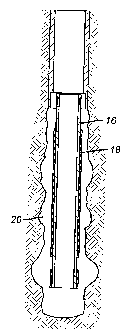Some of the information on this Web page has been provided by external sources. The Government of Canada is not responsible for the accuracy, reliability or currency of the information supplied by external sources. Users wishing to rely upon this information should consult directly with the source of the information. Content provided by external sources is not subject to official languages, privacy and accessibility requirements.
Any discrepancies in the text and image of the Claims and Abstract are due to differing posting times. Text of the Claims and Abstract are posted:
| (12) Patent: | (11) CA 2514967 |
|---|---|
| (54) English Title: | ALTERNATIVE METHOD TO CEMENTING CASING AND LINERS |
| (54) French Title: | PROCEDE DE REMPLACEMENT DESTINE A CIMENTER UN TUBAGE ET DES COLONNES PERDUES |
| Status: | Term Expired - Post Grant Beyond Limit |
| (51) International Patent Classification (IPC): |
|
|---|---|
| (72) Inventors : |
|
| (73) Owners : |
|
| (71) Applicants : |
|
| (74) Agent: | MARKS & CLERK |
| (74) Associate agent: | |
| (45) Issued: | 2008-09-23 |
| (86) PCT Filing Date: | 2004-01-28 |
| (87) Open to Public Inspection: | 2004-08-12 |
| Examination requested: | 2005-07-29 |
| Availability of licence: | N/A |
| Dedicated to the Public: | N/A |
| (25) Language of filing: | English |
| Patent Cooperation Treaty (PCT): | Yes |
|---|---|
| (86) PCT Filing Number: | PCT/US2004/002327 |
| (87) International Publication Number: | WO 2004067906 |
| (85) National Entry: | 2005-07-29 |
| (30) Application Priority Data: | ||||||
|---|---|---|---|---|---|---|
|
A method of sealing casing or liners in a wellbore is described. The stands of
casing or liner (16) receive a jacket (18) bonded to the outer surface.
Preferably, the jacket is a rubber compound bonded to the outer wall. The
formulation responds to well fluids to swell at a predetermined rate. The
casing or liner can also be expanded with a swage preferably prior to the
onset of significant jacket swelling. Packers and sealing hangers can be
optionally added at the extremes of the casing or liner string to further
secure against channeling between adjacent formations.
L'invention concerne un procédé destiné à étanchéifier un tubage ou des colonnes perdues dans un puits de forage. Les supports du tubage ou de la colonne perdue reçoivent un jacket lié à la surface extérieure. De préférence, le jacket est constitué d'un composé de caoutchouc lié à la paroi extérieure. La préparation réagit aux fluides de forage à une vitesse prédéterminée. Le tubage ou le liner peut également être dilaté au moyen d'un redresse-tubes, de préférence avant le début d'un gonflement important du jacket. Des garnitures d'étanchéité et des supports d'étanchéité peuvent éventuellement être ajoutés au niveau des extrémités de la colonne de tubage ou de la colonne perdue en vue d'une protection supplémentaire contre le cheminement préférentiel entre des formations adjacentes.
Note: Claims are shown in the official language in which they were submitted.
Note: Descriptions are shown in the official language in which they were submitted.

2024-08-01:As part of the Next Generation Patents (NGP) transition, the Canadian Patents Database (CPD) now contains a more detailed Event History, which replicates the Event Log of our new back-office solution.
Please note that "Inactive:" events refers to events no longer in use in our new back-office solution.
For a clearer understanding of the status of the application/patent presented on this page, the site Disclaimer , as well as the definitions for Patent , Event History , Maintenance Fee and Payment History should be consulted.
| Description | Date |
|---|---|
| Inactive: Expired (new Act pat) | 2024-01-29 |
| Common Representative Appointed | 2019-10-30 |
| Common Representative Appointed | 2019-10-30 |
| Grant by Issuance | 2008-09-23 |
| Inactive: Cover page published | 2008-09-22 |
| Inactive: Final fee received | 2008-07-07 |
| Pre-grant | 2008-07-07 |
| Notice of Allowance is Issued | 2008-01-08 |
| Letter Sent | 2008-01-08 |
| Notice of Allowance is Issued | 2008-01-08 |
| Inactive: Approved for allowance (AFA) | 2007-12-18 |
| Inactive: Adhoc Request Documented | 2007-11-21 |
| Inactive: Delete abandonment | 2007-11-21 |
| Inactive: Correspondence - Prosecution | 2007-11-01 |
| Amendment Received - Voluntary Amendment | 2007-08-01 |
| Inactive: Abandoned - No reply to s.30(2) Rules requisition | 2007-08-01 |
| Letter Sent | 2007-07-09 |
| Inactive: Single transfer | 2007-05-14 |
| Inactive: S.30(2) Rules - Examiner requisition | 2007-02-01 |
| Inactive: Extension of time for transfer | 2006-11-01 |
| Inactive: IPC from MCD | 2006-03-12 |
| Inactive: Courtesy letter - Evidence | 2005-10-11 |
| Inactive: Cover page published | 2005-10-11 |
| Inactive: Acknowledgment of national entry - RFE | 2005-10-07 |
| Letter Sent | 2005-10-07 |
| Application Received - PCT | 2005-09-21 |
| National Entry Requirements Determined Compliant | 2005-07-29 |
| Request for Examination Requirements Determined Compliant | 2005-07-29 |
| All Requirements for Examination Determined Compliant | 2005-07-29 |
| Application Published (Open to Public Inspection) | 2004-08-12 |
There is no abandonment history.
The last payment was received on 2008-01-08
Note : If the full payment has not been received on or before the date indicated, a further fee may be required which may be one of the following
Please refer to the CIPO Patent Fees web page to see all current fee amounts.
Note: Records showing the ownership history in alphabetical order.
| Current Owners on Record |
|---|
| BAKER HUGHES INCORPORATED |
| Past Owners on Record |
|---|
| BENNETT M. RICHARD |
| MATTHEW J. JABS |
| MICHAEL A. CARMODY |